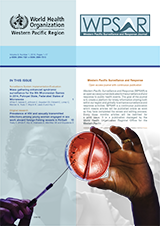Mass gathering enhanced syndromic surveillance for the 8th Micronesian Games in 2014, Pohnpei State, Federated States of Micronesia
DOI:
https://doi.org/10.5365/wpsar.2016.7.4.001Abstract
Pohnpei State’s Division of Primary Health Care implemented enhanced surveillance for early warning and detection of disease to support the 8th Micronesian Games (the Games) in July 2014.
The surveillance comprised 11 point-of-care sentinel sites around Pohnpei, Federated States of Micronesia, collecting data daily for eight syndromes using standard case definitions. Each sentinel site reported total acute care encounters, total syndrome cases and the total for each syndrome. A public health response, including epidemiological investigation and laboratory testing, followed when syndrome counts reached predetermined threshold levels.
The surveillance was implemented using the web-based Suite for Automated Global Electronic bioSurveillance Open-ESSENCE (SAGES-OE) application that was customized for the Games. Data were summarized in daily situation reports (SitReps) issued to key stakeholders and posted on PacNet, a Pacific public health e-mail network.
Influenza-like illness (ILI) was the most common syndrome reported (55%, n = 225). Most syndrome cases (75%) were among people from Pohnpei. Only 30 cases out of a total of 408 syndrome cases (7%) presented with acute fever and rash, despite the large and ongoing measles outbreak at the time. No new infectious disease outbreak was recorded during the Games. Peaks in diarrhoeal and ILI cases were followed up and did not result in widespread transmission.
The technology was a key feature of the enhanced surveillance. The introduction of the web-based tool greatly improved the timeliness of data entry, analysis and SitRep dissemination, providing assurance to the Games organizers that communicable diseases would not adversely impact the Games.

